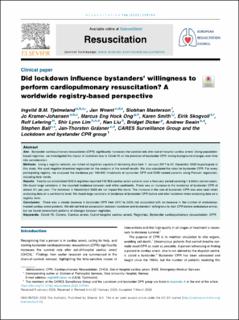| dc.contributor.author | Tjelmeland Myrhaugen, Ingvild Beathe | |
| dc.contributor.author | Wnent, Jan | |
| dc.contributor.author | Masterson, Siobhan | |
| dc.contributor.author | Kramer-Johansen, Jo | |
| dc.contributor.author | Ong, Marcus Eng Hock | |
| dc.contributor.author | Smith, Karen | |
| dc.contributor.author | Skogvoll, Eirik | |
| dc.contributor.author | Lefering, Rolf | |
| dc.contributor.author | Lim, Shir Lynn | |
| dc.contributor.author | Liu, Nan | |
| dc.contributor.author | Dicker, Bridget | |
| dc.contributor.author | Swain, Andrew | |
| dc.contributor.author | Ball, Stephen | |
| dc.contributor.author | Gräsner, Jan-Thorsten | |
| dc.date.accessioned | 2023-08-29T10:48:55Z | |
| dc.date.available | 2023-08-29T10:48:55Z | |
| dc.date.created | 2023-04-18T13:53:26Z | |
| dc.date.issued | 2023 | |
| dc.identifier.citation | Resuscitation. 2023, . | en_US |
| dc.identifier.issn | 0300-9572 | |
| dc.identifier.uri | https://hdl.handle.net/11250/3086168 | |
| dc.description.abstract | Aim
Bystander cardiopulmonary resuscitation (CPR) significantly increases the survival rate after out-of-hospital cardiac arrest. Using population-based registries, we investigated the impact of lockdown due to Covid-19 on the provision of bystander CPR, taking background changes over time into consideration.
Methods
Using a registry network, we invited all registries capable of delivering data from 1. January 2017 to 31. December 2020 to participate in this study. We used negative binominal regression for the analysis of the overall results. We also calculated the rates for bystander CPR. For every participating registry, we analysed the incidence per 100 000 inhabitants of bystander CPR and EMS-treated patients using Poisson regression, including time trends.
Results
Twenty-six established OHCA registries reported 742 923 cardiac arrest patients over a four-year period covering 1.3 billion person-years. We found large variations in the reported incidence between and within continents. There was an increase in the incidence of bystander CPR of almost 5% per year. The lockdown in March/April 2020 did not impact this trend. The increase in the rate of bystander CPR was also seen when analysing data on a continental level. We found large variations in incidence of bystander CPR before and after lockdown when analysing data on a registry level.
Conclusion
There was a steady increase in bystander CPR from 2017 to 2020, not associated with an increase in the number of ambulance-treated cardiac arrest patients. We did not find an association between lockdown and bystanders’ willingness to start CPR before ambulance arrival, but we found inconsistent patterns of changes between registries. | en_US |
| dc.language.iso | eng | en_US |
| dc.publisher | Elsevier | en_US |
| dc.rights | Navngivelse 4.0 Internasjonal | * |
| dc.rights.uri | http://creativecommons.org/licenses/by/4.0/deed.no | * |
| dc.title | Did lockdown influence bystanders’ willingness to perform cardiopulmonary resuscitation? A worldwide registry-based perspective | en_US |
| dc.title.alternative | Did lockdown influence bystanders’ willingness to perform cardiopulmonary resuscitation? A worldwide registry-based perspective | en_US |
| dc.type | Peer reviewed | en_US |
| dc.type | Journal article | en_US |
| dc.description.version | publishedVersion | en_US |
| dc.source.pagenumber | 0 | en_US |
| dc.source.journal | Resuscitation | en_US |
| dc.identifier.doi | 10.1016/j.resuscitation.2023.109764 | |
| dc.identifier.cristin | 2141628 | |
| cristin.ispublished | true | |
| cristin.fulltext | original | |
| cristin.qualitycode | 2 | |

